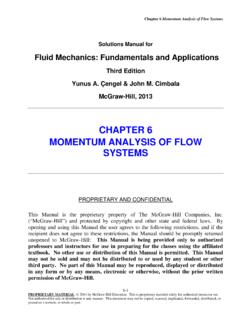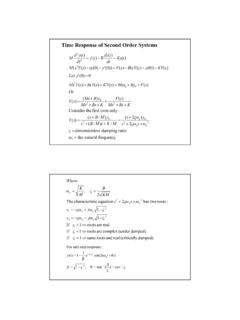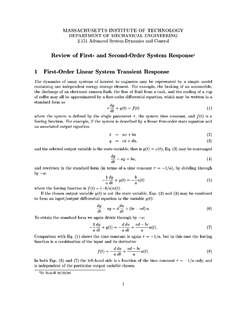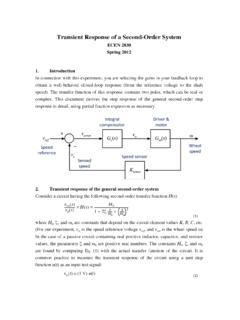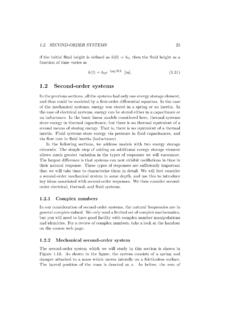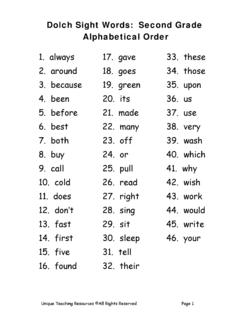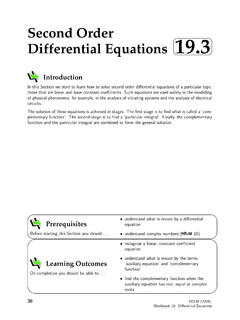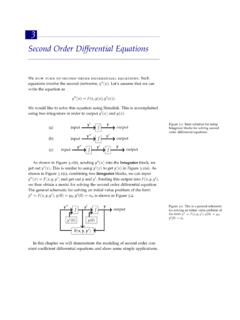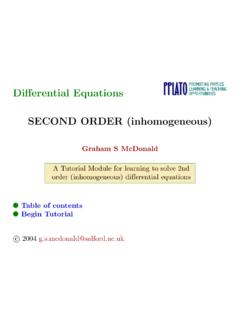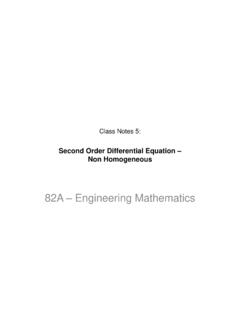Transcription of Second Order Systems
1 1 Second Order SystemsSecond Order Equations()1222++=ssKsG Standard Form 2d2ydt2+2 dydt+y=Kf(t)Corresponding Differential EquationK = Gain = Natural Period of Oscillation = Damping Factor (zeta)Note: this has to be !!!2 Origins of Second Order Equations1. Multiple Capacity Systems in SeriesK1 1s+1K2 2s+1becomeorK1K2 1s+1() 2s+1()K 2s2+2 s+12. Controlled Systems (to be discussed later)3. Inherently Second Order Systems Mechanical Systems and some sensors Not that common in chemical process controlExamination of the Characteristic Equation 2s2+2 s+1=0 Two complex conjugate rootsUnderdamped0 < < 1 Two equal real rootsCritically Damped = 1 Two distinct real rootsOverdamped > 13 Response of 2ndOrder System to StepInputsFast, oscillations occurUnderdampedEq. 5-51 Faster than overdamped, no oscillationCritically dampedEq. 5-50 Sluggish, no oscillationsOverdampedEq. 5-48 or 5-49 Ways to describe underdamped responses: Rise time Time to first peak Settling time Overshoot Decay ratio Period of oscillationResponse of 2ndOrder Systemsto StepInput ( 0 < < 1)1.
2 Rise Time:tris the time the process output takes to first reach the new steady-state Time to First Peak: tpis the time required for the output to reach its first maximum Settling Time: tsis defined as the time required for the process output to reach and remain inside a band whose width is equal to 5% of the total change in y. The term 95% response time sometimes is used to refer to this case. Also, values of 1% sometimes are Overshoot:OS= a/b(% overshoot is 100a/b).5. Decay Ratio: DR= c/a(where cis the height of the Second peak).6. Period of Oscillation: Pis the time between two successive peaks or two successive valleys of the response.() + = tteKMtyt 222/1sin11cos1Eq. 5-514 Response of 2ndOrder Systemsto StepInput 0 < < 1 1 Note that < 0 gives an unstable solutionas , tr and OS (5-52) 21 =pt (5-53 =21exp OS ()[]()[]222lnlnOSOS+= Above (5-56) (5-54) () ==2212exp OSDR (5-55) 212 =P P 212 = Above (5-57) (5-60) () 12cos11 =rt Relationships between OS, DR, P and , for stepinput to 2ndorder system, underdamped solution()1,12)(22<++= sssKMsY5 Response of 2ndOrder System to SinusoidalInputOutput is also oscillatoryOutput has a different amplitude than the inputAmplitude ratio is a function of , (see Eq.))
3 5-63)Output is phase shifted from the inputFrequency must be in radians/time!!! (2 radians = 1 cycle)P = time/cycle = 1/( ), 2 = , so P = 2 / (where = frequency in cycles/time)SinusoidalInput, 2ndOrder System(Section ) Input = A sin t, so A is the amplitude of the inputfunction is the frequency in radians/time At long times (so exponential dies out),A is the outputamplitude()[]()22221 + =KAA(5-63)Bottom line:We can calculate how the output amplitude changesdue to a sinusoidal inputNote: There is also an equationfor the maximum amplituderatio (5-66)Note log scale6 Road Map for 2ndOrder EquationsStandard FormStepResponseSinusoidalResponse(long- time only)(5-63)Other InputFunctions-Use partialfractionsUnderdamped0 < < 1(5-51)Criticallydamped = 1(5-50)Overdamped > 1(5-48, 5-49)Relationship betweenOS, P, trand , (pp. 119-120)Example Heated tank + controller = 2ndorder system(a) When feed rate changes from to kg/s (step function), Ttankchanges from 100 to 102 C.
4 Find gain (K) of transfer function:7 Road Map for 2ndOrder EquationsStandard FormStepResponseSinusoidalResponse(long- time only)(5-63)Other InputFunctions-Use partialfractionsUnderdamped0 < < 1(5-51)Criticallydamped = 1(5-50)Overdamped > 1(5-48, 5-49)Relationship betweenOS, P, trand , (pp. 119-120)Example Heated tank + controller = 2ndorder system(a) When feed rate changes from to kg/s (step function), Ttankchanges from 100 to 102 C. Find gain (K) of transfer function:8 Example Heated tank + controller = 2ndorder system(b) Response is slightly oscillatory, with first two maxima of and C at 1000 and 3600 is the complete process transfer function?Example Heated tank + controller = 2ndorder system(c) Predict tr:9 Example Thermowell + CSTR = 2ndorder system(a) Find , :()()( )110131)(++= sssTsTreactormeasCSTRT hermocoupleRoad Map for 2ndOrder EquationsStandard FormStepResponseSinusoidalResponse(long- time only)(5-63)Other InputFunctions-Use partialfractionsUnderdamped0 < < 1(5-51)Criticallydamped = 1(5-50)Overdamped > 1(5-48, 5-49)Relationship betweenOS, P, trand , (pp.)
5 119-120)10 Example Thermowell + CSTR = 2ndorder system(a) Find , :()()( )110131)(++= sssTsTreactormeasExample Thermowell + CSTR = 2ndorder system(b) Temperature cycles between 180 and 183 C, with period of 30 , :A 11 Example Thermowell + CSTR = 2ndorder system(c) Find A (actual amplitude of reactor sine wave).




